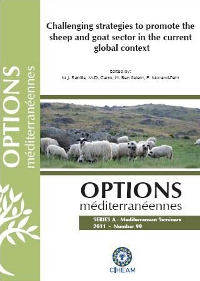| Article précédent | p. 31-34 | Article suivant |
Meal criterion and feeding behaviour in sheep and goats
The present study is aimed to determine meal criterion and other eating behavioural parameters for sheep and goats. Three non-lactating sheep and 3 non-lactating goats were fed with a total mixed ration having 50/50 roughage to concentrate ratio ad-libitum. Grounded alfalfa hay having 1.5-2 cm size was used as roughage. Meal pattern of each animal was recorded by electronic feeder scales (30±0.005 kg of capacity) connected to a computer with R-S232 multiplier. The system recorded meal length (beginning date-time and ending date-time for bout) and bout-size (beginning weight and ending weight) for each balance, getting stability after 5 seconds and 30 g feed consumed from the scale feeder for 24 h during 30 days. At the end of study it was obtained that mean value for meal criterion was 13.19 min for goats and 21.84 min for sheep, while inter-meal interval (89.04 min for goat vs 105.07 for sheep), meal length (25.41 min for goat vs 20.67 min for sheep), meal size (161.20 g/meal for goat vs 158.06 g/meal for sheep), eating rates (9.98 g/min for goat vs 13.46 g/min for sheep), total feed intake (1.71 kg/day for gout 1.39 kg/day for sheep) and total eating length (269.56 min/day vs 185.93 min/day) did not change significantly with respect to species (P>0.05) except meal number (10.75 for goat vs 8.94 for sheep). In conclusion, goats have lower meal criterion as a reflection of higher meal number when compared to sheep.
Cette étude a pour objet la détermination des critères de repas et des comportements alimentaires des moutons et des chèvres. Trois brebis et trois chèvres non allaitantes ont été nourries avec une ration totale mélangée dont le rapport fourrage:concentré était de 50:50. Du foin de luzerne de 1,5 à 2 cm a été employé comme fourrage. Le modèle de repas de chaque animal a été enregistré par des balances électroniques (30±0,005 kilogramme de capacité) reliées à un ordinateur équipé d'un multiplicateur RS232. Le système a enregistré la durée du repas (date-heure de début et de fin par accès) et la quantité mangée par repas (poids de départ et poids final) pour chaque balance en obtenant la stabilité après 5 secondes d'alimentation, 30 g consommés pour 24 h pendant l'étude de 30 jours. À la fin de l'étude, la valeur moyenne obtenue pour les critères de repas était de 13.19 minutes pour les chèvres et 21,84 min pour les moutons tandis que l'intervalle d'inter-repas (89,04 min pour les chèvres contre 105,07 min pour les moutons), la durée du repas (25,41 min pour les chèvres contre 20,67 min pour les moutons), la taille du repas (161,20 g/repas pour la chèvre contre 158,06 g/repas pour des moutons), le rythme d'ingestion (9,98 g/min pour la chèvre contre 13,46 g/min pour des moutons), l'ingestion totale (1,71 kg/jour contre 1,39 kg/jour) et la durée totale de consommation (269,56 minutes/jour contre 185,93 minutes/jour) n'étaient pas changés significativement selon l'espèce (P>0,05) excepté le nombre de repas (10,75 pour la chèvre contre 8,94 pour des moutons). En conclusion les chèvres ont des critères de repas inférieurs aux moutons en réponse au nombre élevé de repas comparé aux moutons.
- [ Afficher ]
- [ Télécharger ]
- [ Exporter la citation ]
Vous pouvez télécharger la citation au format :
- [ Imprimer ]
-
Mots-clés
CAPRIN, COMPORTEMENT ALIMENTAIRE, FREQUENCE DES REPAS, OVIN, PRISE ALIMENTAIRE (ANIMAUX)Citer cet article
Gorgulu M., Boga M., Sahinler S., Kilic U., Darcan N. Meal criterion and feeding behaviour in sheep and goats. In : Ranilla M.J. (ed.), Carro M.D. (ed.), Ben Salem H. (ed.), Morand-Fehr P. (ed.). Challenging strategies to promote the sheep and goat sector in the current global context. Zaragoza : CIHEAM / CSIC / Universidad de León / FAO, 2011. p. 31-34. (Options Méditerranéennes : Série A. Séminaires Méditerranéens; n. 99). 13. International Seminar of the Sub-Network on Nutrition of the FAO-CIHEAM Inter-Regional Cooperative Research and Development Network on Sheep and Goats, 2009/10/14-16, León (Spain). http://om.ciheam.org/om/pdf/a99/00801532.pdf



